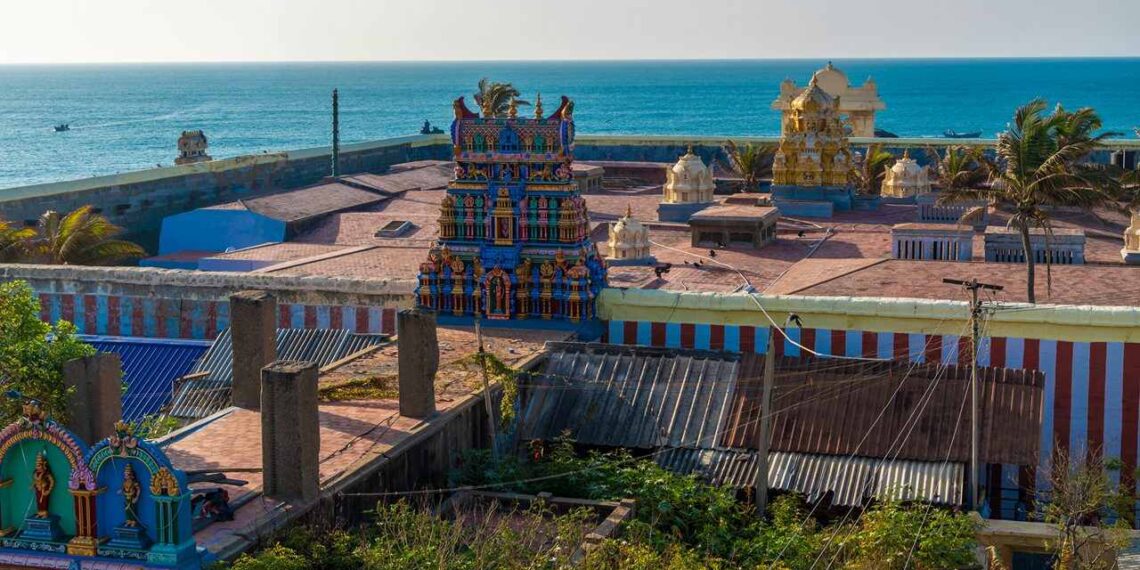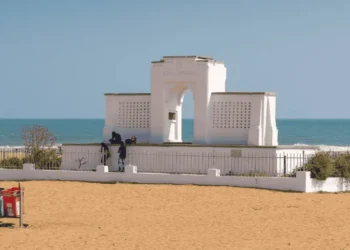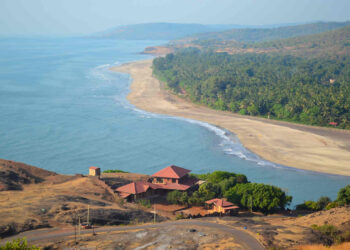The Kumari Amman Temple is located in Kanyakumari, Tamil Nadu, where the Arabian Sea, Bay of Bengal, and Indian Ocean meet. It’s a holy spot dedicated to Goddess Parvati, worshipped as Kumari Amman, the young goddess who never marries. The temple is right by the sea, its gopuram standing tall against the waves. It covers about 2 acres, not too big, but it feels special with prayers, camphor smells, and the sound of the ocean. Pilgrims and devotees from all over Indian subcontinent come to here to worship the goddess and pray for the fulfillment of desires.
Legend of the Temple
The temple is steeped in legend. Long ago, a great demon called Banasura got a blessing that made him almost impossible to defeat, except by a young virgin goddess. He started causing trouble all over the three worlds, defeating divine beings and gods. Parvati took the form of Kumari, a young, pure goddess, and decided to stop him. She went to Kanyakumari, a sacred place, and prayed hard to get the strength to fight him to lord Shiva.
While she was praying, Lord Shiva saw her devotion and agreed to marry her. But the sage Narada knew if they got married, Kumari couldn’t beat Banasura. So, he made a plan and tricked the wedding group, making them miss the right time. The wedding didn’t happen, and Kumari stayed a virgin, keeping her power. She fought Banasura and won, saving everyone. The temple’s murti(idol), Kumari Amman, reflects her young countenance and palpable power. Another interesting story says her nose ring was so bright it helped sailors find their way at night, like a lighthouse. These tales make the temple feel like it’s got a life of its own.
History of Kumari Amman Temple
The temple’s past goes back a long way, mentioned in old Tamil books like the Purananuru from around 300 BCE to 300 CE. People might have worshipped the goddess here even earlier, tied to old local ways. The building we see now started coming together between the 8th and 17th centuries, built by different kings.
The Pandya kings, from the 6th to 14th centuries, were big helpers. They made the sanctum and gopuram, and stones from their time show they gave land and gold for lamps. The Chola kings, from the 9th to 13th centuries, added carvings and halls. By the 10th century, the temple was a busy place with fishermen, traders, and priests all helping out, as village records say.
The Vijayanagara kings, from the 14th to 16th centuries, made it tougher, adding walls and pillars. The Nayaks of Madurai, from the 16th to 18th centuries, put in carvings that still look amazing. In the 1300s, invaders from the north caused problems, but priests and local people hid the temple’s treasures. The Vijayanagara kings later fixed things up, bringing back prayers and rituals.
In the 1700s, the French took Kanyakumari in 1757, then the British in 1760. Tippu Sultan came in 1790. The temple stayed strong through all this. By 1855, the British were in charge of it, and in 1951, Tamil Nadu’s HR&CE Board took over, keeping its ways going.
The temple’s spiritual side comes from worshipping the goddess, tied to books like the Devi Mahatmyam. It’s a Shakti Peeth, where the goddess’s back is said to have fallen, making it very holy among Shakta tradition.
Architecture of the Temple
The Kumari Amman Temple is Dravidian style, covering about 2 acres. Its main gopuram, around 60 feet high, has carvings of the goddess, gods, and old stories, looking strong by the sea. Smaller doorways lead to a courtyard where the sanctum has Kumari Amman’s idol, a small figure with gold and a bright nose ring.
The navarathri mandapam, a hall for festivals, has pillars with carvings of dancers and animals, made by the Nayaks. A small tank for ritual baths is nearby, showing the gopuram’s reflection. Shrines for Ganesha and Subrahmanya are there, each with a peaceful feel. The flagstaff, covered in gold, was given by a Pandya king. Some wall carvings from Vijayanagara times show stories from the Devi Mahatmyam, making every part feel like history.
The temple’s small, but it feels close and soothing, like you’re right with the goddess. The sea’s sound mixes with the priests’ chants, making it special.
Religious Significance and Festivals
For people who pray to the goddess, the Kumari Amman Temple is a powerful place, a Shakti Peeth. The story of Kumari beating Banasura makes it a spot to ask for strength or help. People bring flowers, coconuts, or join abhishekam, feeling the goddess’s power. As a Shakti Peeth, it’s named in old holy books, giving it deep meaning. Women often come to honor Kumari as a sign of purity and strength. The nose ring, said to guide sailors, connects the temple to the sea’s people.
Festivals make the temple lively. Navaratri, a 10-day festival in September or October, is the biggest, with the goddess dressed in nine forms, bringing lots of people. The navarathri mandapam has music and Bharatanatyam dances, showing Kumari’s power. Chitra Pournami, a full-moon day, has processions by the sea. Six daily rituals, from morning to night, with priests chanting and lighting lamps, keep the temple’s rhythm.
The temple is a big part of Tamil culture. Its tie to old books like the Purananuru and Devi Mahatmyam shapes goddess worship here. Festivals bring Carnatic music and Bharatanatyam, keeping Tamil arts alive, and the carvings show life from long ago. The temple’s place in Kanyakumari, where three waters meet, makes it special, tied to Tamil Nadu’s sea life.
Today, it brings people from everywhere—Kanyakumari is 700 km from Chennai or 90 km from Trivandrum, easy by train or bus. Pilgrims bathe at the Triveni Sangam, where the seas join, before praying. The temple connects Tamil Nadu’s past and present, keeping faith, art, and history going. Stories like the nose ring’s light or Kumari’s fight are in local songs, passed down by families.
Conclusion
The Kumari Amman Temple is definitely a must visit for those who have faith in the goddess. In fact, one can also visit the temple solely for it’s majestic beauty and architecture. The constant worship of the goddess for more than 2 millennia has made the place very powerful and one can even sense the presence of the goddess if one is little sensitive. All in all, the temple calls thousands who love the goddess, whose presence fills this holy kshetra.











